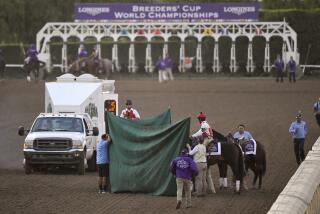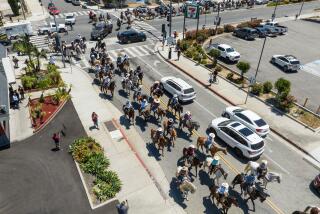Horse Sense
- Share via
True, John Wayne would have looked a bit silly. And you almost need a white hat to shout “Hi-yo, Silver!” with any style on the trail. But there’s a big push in the equestrian world these days to wear helmets on horseback--even if you’re pleasure riding in a Western saddle and not jumping hurdles in competition.
“I don’t put my foot in the stirrup unless I’m wearing a helmet,” said Ruthanna Bridges, who teaches Western and English riding at her Bridges Training Stable in Santiago Canyon.
Last week, a horse stumbled during a lesson and threw a seasoned rider into a fence, headfirst. The rider was shaken up, Bridges said, but “without her helmet, she would have been looking at a serious head injury.”
Making Inroads Into Safety
Though helmets and other safety equipment are more prevalent than ever, there’s a bit of a brouhaha among equestrians over them. The Kentucky-based American Horse Show Assn., which sanctions 2,700 events annually, requires helmets only in its more arduous events; too many riders want the freedom to decide in “flat land” events that don’t require jumping or heavy riding.
One of the biggest challenges is getting Western-style casual riders who gently make their way around the hilly trails of Orange County and elsewhere to wear helmets rather than cowboy hats.
“There’s a perception that riding on the trail is a little less dangerous,” said Jacqui Moreland, who teaches riding at Rio Vista Stables in San Juan Capistrano.
People such as Dave Johnson, a riding instructor from Phoenix, have made some inroads in recent years in promoting helmet use. Johnson is leader of the horse association’s safety standards committee. It recently got the group to pass a provision that all riders younger than 18 must wear helmets in every sanctioned event. It goes into effect Dec. 1, 2001.
“It’s the right step,” Johnson said. “The goal would be to get everyone to wear helmets. Maybe this will encourage some of the adults to show leadership and set an example.”
The association’s spokeswoman, Nicole Migliarese, calls it a “gray area” for the national group right now.
But she adds that, unofficially, the group “highly recommends” helmets for most events. She knows from experience. Her horse once threw her during a jumping event; she’s convinced wearing a helmet saved her life, or at least prevented a permanent head injury.
Bridges of Santiago Canyon passes this along to her students: “Those who don’t wear a helmet don’t really need one, because obviously they don’t have a brain to begin with.”
If you aren’t convinced by the riding experts, maybe a word from the American Society for Testing and Materials will help. Dru Malavase, who has helped develop equestrian safety standards for the group, points out that you don’t have to hit your head in a fall to cause head damage. She explained to Equus magazine, which serves the riding industry:
“When you fall off a horse, your body will come to a stop when you hit the ground, but your brain keeps traveling at the same speed. It will slam into the inside of your skull, and may even bounce back to the other side and slam into it again.”
The helmet, she said, serves as an air bag, to prevent such slamming.
The Other Side of the Fence
With all these warnings, why would experienced riders not wear a helmet? I asked a friend, a horse rider with a lot of common sense. She likes the freedom of her hair blowing in the wind, and the sense of living a little dangerously. She also finds the helmet confining and uncomfortable. She’s far from alone.
Moreland, the San Juan Capistrano instructor, said she always recommends a helmet for competition. But she and her friends never use them for Western pleasure riding. She admits it’s not very good judgment, because she’s seen people get injured from just standing next to a horse.
Jan Dawson, author of “Teaching Safe Horsemanship,” said 80% of horse-related injuries come from falls, and more than half of those during pleasure riding.
She and her husband, Robert O. Dawson, operate the American Assn. of Horsemanship Safety. They provide seminars on horse safety and serve as expert witnesses in lawsuits involving horse accidents. And it’s the lawsuits, she points out, that you ought to be worried about.
Without a helmet, she said:
“If you’re seeking an insurance claim, and a lawyer asks you in court, ‘Were you aware that a helmet was readily available?,’ then you’re pretty much toast.”
A Horse Is a Horse, of Course, of Course
Dawson points out another misperception that causes accidents. Horses are not our pals--they’re animals with natural instincts that might override what you want.
“Too many people give a horse human qualities that it doesn’t have,” Dawson said.
And that can lead to spills from the saddle, when a helmet can come in handy.
With the upcoming rules for juvenile riders in sanctioned horse shows, Dave Johnson is convinced helmet manufacturers will work harder to create an attractive helmet that will meet high standards. But it might not matter for a lot of young riders--or their parents.
Jill Jones, one of my editors and an expert equestrian, says it’s sad to see parents who insist their child wear a helmet on a bicycle, but think nothing of sending the child off without one on a 900-pound horse that might get spooked at the mere sight of a rabbit.
No, you wouldn’t see John Wayne wearing a helmet. But my guess is that if he were still around, you’d see him on TV urging young horse riders to not hit the stirrups without one.
More to Read
Sign up for The Wild
We’ll help you find the best places to hike, bike and run, as well as the perfect silent spots for meditation and yoga.
You may occasionally receive promotional content from the Los Angeles Times.






